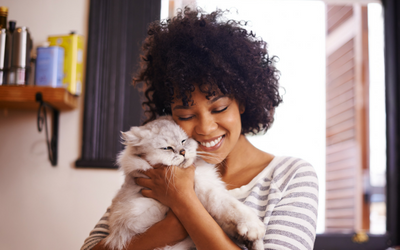
June 4th marks International Hug Your Cat Day – a day devoted to hugging cats around the world! Most cat owners don’t need an excuse to show their furry companion some love, but June 4th is a good reminder to give some extra cuddles to your cat!
While you enjoy a snuggle with Kitty, consider how well you really know your furry friend!
Have you ever seen cats bumping noses? Cats who know each other will confirm visual recognition by sniffing each other’s noses. They share scents and learn each other’s history with this nose bumping greeting. Nose touching is considered a polite greeting. Say hello to Kitty with a nose touch – you can use your finger instead of your nose if you prefer!
Master manipulators? Studies have found that some cats will combine a purr with a meow to control their owner’s behavior. This “solicitation purr” is more likely to get you out of bed to fill her food bowl, than constant meowing. Some cats will make their cries more urgent to get their owner’s attention.
Eye contact. Cats use eye contact and eye movement to communicate with each other. Cats will stare each other down as an intimidation technique. If one of them blinks, it signals she’s giving in. When a cat makes accidental eye contact, she will blink and narrow her eyes. This communicates that she’s not being aggressive. If you want to make friends with an unfamiliar cat, blink and then look away when you catch her eye.
Love blinks. Long, slow blinks are a cat’s way of saying “I love you”. Closing her eyes in your presence is the ultimate sign of trust.
Purrs and meows. Cats can purr continually as they inhale and exhale. Young cats purr in monotone, while older cats have can have 2-3 rich notes. Cats have a repertoire of sounds. They will use their kitten sounds to communicate with their people, but use a different repertoire of sounds with other cats.
Cat naps. On average, cats spend about 2/3 of their day sleeping. Cats usually nap throughout the day, but when they go into a deep sleep, they produce the same brainwave patterns that we do when we dream. This is why you might see your cat’s whiskers twitch or hear a growl when she’s asleep – she might be dreaming of chasing a mouse or playing with a catnip toy!
Hugs lead to happiness, so hug your cat today!